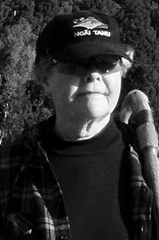He KōreroreroHaere rā e Jude
Apr 15, 2013

Nā Keri Hulme
I came back home.
There is the chitter of sparrows and the annoying activities of starlings, and the occasional squark from a gull or two and a bit of a tune from blackbirds in the morning.
I wonder where the tūī and bellbirds have gone…
The cicadas are getting coolweather-drowsy.
There are few people to be seen.
My house is – as it was when I left it, a fortnight or so ago.
Spider-riddled, overgrown with books, and no longer “home”.
I did not expect sobbing crowds or a choir of kōtuku – waua! That would’ve been – weird! I just didn’t realise how the silence – and the dark – would hit me.
Judith Maloney wasn’t always my naybore: she, and her mate, Bill Minehan, arrived some years after I did. But – from the beginning when Bill, with his wonderful Irish horsey face, leaned over the nonfence and said, “This is your neighbour. You’ll love one another and fight and make mayhem and be strong for each other. That’s what neighbours do.”
I sure as shit didn’t believe him.
Bill – a farmer from Harihari – who’d runaway with Jude, knew a thing or three more than I did.
Over the next three decades plus, we learned to know one another – as friends, as neighbours – and, especially when Jude and I worked in the Franz Josef Post (FJP), as naybores.
We invented fitch recipes (don’t ask). We invented the Ōkarito Free Republic (you can gather we weren’t exactly right-wing people). Jude relocated a spare Post Office flag and turned it into our first OFR flag. I turned into the Flag Warden of the Ōkarito Free Republic (a post I am really proud to still hold. Vexillologist from way back, I so loved Judith’s flags, made for the community.) Later on, when the FJG PO closed, she and her wonderful bracketed mate, Bill, relocated the PO flag pole too… we hoisted flags on it on her rā haerenga roa – and actually, all round the place. Because, Judith was a wonderful weaver, maker of fabrics, creator.
We loved food (one of my proudest achievements is that I taught her kids how to put down a hāngī) and we loved drink – our whisky (single malt) parties are remembered by all who partook – especially those we heaved out of ditches or shovelled off home …
And so, and sob –
Jude knew she was dying. She bought her own coffin, and her son-in-law assembled it during that time. As a weaver, creatrix, fabric-oriented person, she had collected striking colourful pieces to make her shroud – and when a call went round the village for additional bits, most of us offered other stuff.
My offering was strikingly grey. It was part of the hood-lining of my first Swannie, the one I wore while building the foundations of my home. The moths had got all the rest …
So: as is often the case in small rural communities – and especially in Māori communities (which Ōkarito is not), the locals got together when Jude was comatose, and unlikely to survive too much longer.
We’d had practice. When her mate, Bill Minehan died, he was lying on the sofa in their main room (Jude had made the cover for the sofa.)
He had his phone in hand – he’d just finished welding on a new bull bar for his Holden ute. One of my nurse sisters (who’d come to Big O for r and r!) diagnosed Bill dead.
And – the community swung into action.
We knew about erecting marquees: we knew about getting various people to cook, make savouries and sandwiches: we knew how to “organise stuff”, which is what people in wee places have to get to know. We’d had experience with deaths in the settlement before.
And so, Bill embalmed, came back to here, and a local bloke made his coffin (out of Bill’s tōtara, stacked in the shed, and another local, a merchant seaman, overnight wove immaculate rope work handles, and all of us visiting brought candles, and whisky, and wee things to pop in the coffin. A copy of his 4-inch adjustable spanner. Lollies. Cigarettes. And – the first time I saw this done on the Coast (tho’ I’ve seen it many times since) people threw in $2 coins. A nice cross-over between Māori and Pākehā beliefs-
I haven’t seen a kōtuku around yet.
It is weirdly quiet.
Even the sea seems a bit subdued.
Is it because my Naybore was cremated?
Nah, I think not.
People choose their own exits.
For me, it would be, I owe Earth a body, and others have their own choices and options.*
Jude left so many wonderful works — wool-panels, floor cushions, hangings, my most loved swannie and jerkin – and will be remembered by those as well as all who knew her. Most of all, she encouraged a thriving tradition of hospitality here, among her kids and grandkids, among her work with mental health services, and among all others whom she met.
Haere rā e Jude – ki te tini i te raki – taku aroha nui, nā – Keri – te Naybore.